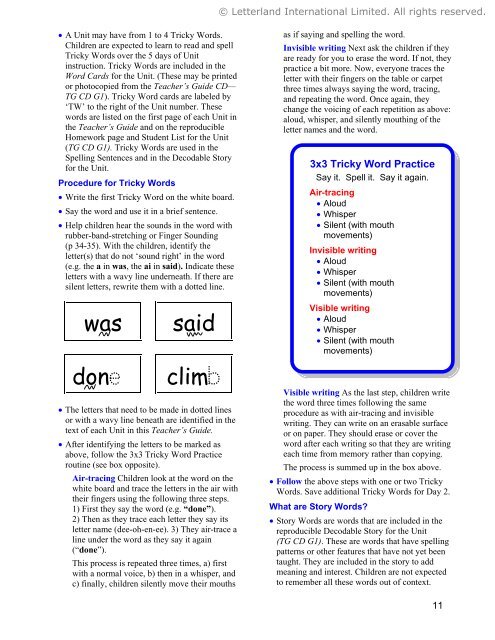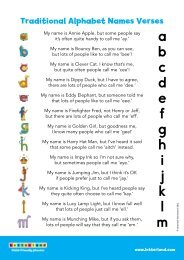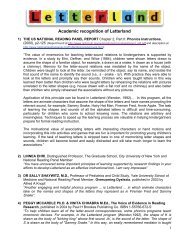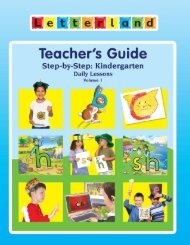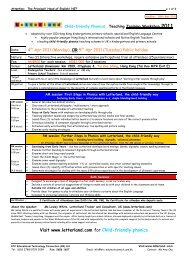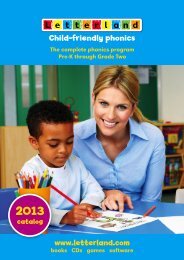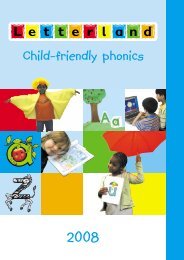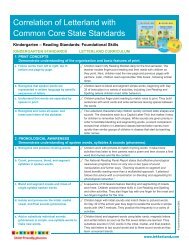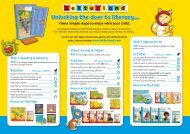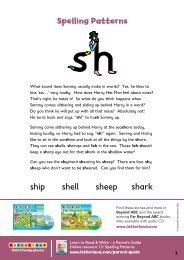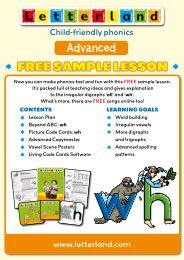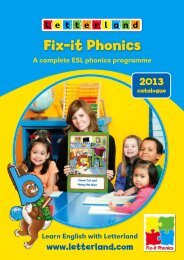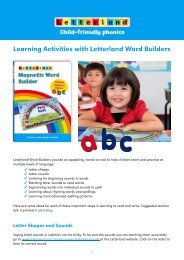Teacher's Guide - Letterland
Teacher's Guide - Letterland
Teacher's Guide - Letterland
You also want an ePaper? Increase the reach of your titles
YUMPU automatically turns print PDFs into web optimized ePapers that Google loves.
© <strong>Letterland</strong> International Limited. All rights reserved.• A Unit may have from 1 to 4 Tricky Words.Children are expected to learn to read and spellTricky Words over the 5 days of Unitinstruction. Tricky Words are included in theWord Cards for the Unit. (These may be printedor photocopied from the Teacher’s <strong>Guide</strong> CD—TG CD G1). Tricky Word cards are labeled by‘TW’ to the right of the Unit number. Thesewords are listed on the first page of each Unit inthe Teacher’s <strong>Guide</strong> and on the reproducibleHomework page and Student List for the Unit(TG CD G1). Tricky Words are used in theSpelling Sentences and in the Decodable Storyfor the Unit.Procedure for Tricky Words• Write the first Tricky Word on the white board.• Say the word and use it in a brief sentence.• Help children hear the sounds in the word withrubber-band-stretching or Finger Sounding(p 34-35). With the children, identify theletter(s) that do not ‘sound right’ in the word(e.g. the a in was, the ai in said). Indicate theseletters with a wavy line underneath. If there aresilent letters, rewrite them with a dotted line.wasdonsaidclim• The letters that need to be made in dotted linesor with a wavy line beneath are identified in thetext of each Unit in this Teacher’s <strong>Guide</strong>.• After identifying the letters to be marked asabove, follow the 3x3 Tricky Word Practiceroutine (see box opposite).Air-tracing Children look at the word on thewhite board and trace the letters in the air withtheir fingers using the following three steps.1) First they say the word (e.g. “done”).2) Then as they trace each letter they say itsletter name (dee-oh-en-ee). 3) They air-trace aline under the word as they say it again(“done”).This process is repeated three times, a) firstwith a normal voice, b) then in a whisper, andc) finally, children silently move their mouthsas if saying and spelling the word.Invisible writing Next ask the children if theyare ready for you to erase the word. If not, theypractice a bit more. Now, everyone traces theletter with their fingers on the table or carpetthree times always saying the word, tracing,and repeating the word. Once again, theychange the voicing of each repetition as above:aloud, whisper, and silently mouthing of theletter names and the word.3x3 Tricky Word PracticeSay it. Spell it. Say it again.Air-tracing• Aloud• Whisper• Silent (with mouthmovements)Invisible writing• Aloud• Whisper• Silent (with mouthmovements)Visible writing• Aloud• Whisper• Silent (with mouthmovements)Visible writing As the last step, children writethe word three times following the sameprocedure as with air-tracing and invisiblewriting. They can write on an erasable surfaceor on paper. They should erase or cover theword after each writing so that they are writingeach time from memory rather than copying.The process is summed up in the box above.• Follow the above steps with one or two TrickyWords. Save additional Tricky Words for Day 2.What are Story Words?• Story Words are words that are included in thereproducible Decodable Story for the Unit(TG CD G1). These are words that have spellingpatterns or other features that have not yet beentaught. They are included in the story to addmeaning and interest. Children are not expectedto remember all these words out of context.11


